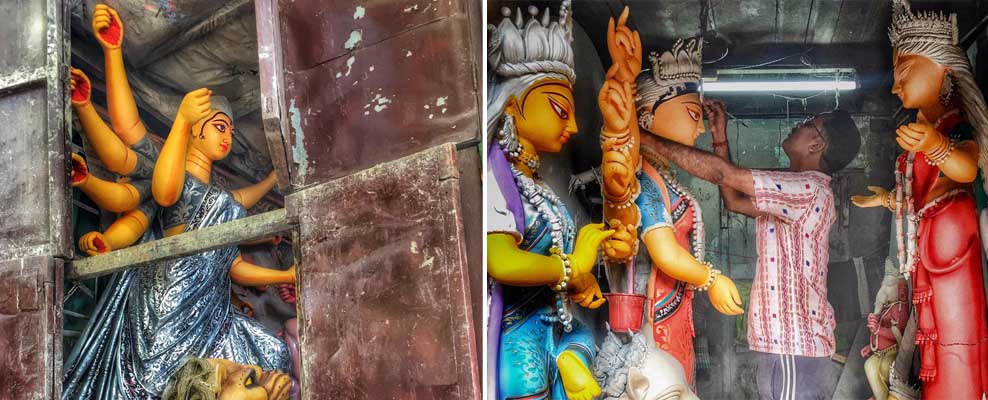The skies over Kolkata have turned a distinct blue.
The clouds are fleecy and white.
A little away from the city near the paddy fields the “kash phool” (thistle like white grass flowers) has grown beautifully wild.
Sharadiya Shobha i.e. the beauty of Autumn in my city.
The season for The Devi to come to her earthly abode.
One part of the city tucked away in the Northern quarters between the Ganges and Chitpur is at its busiest just a day before Mahalaya which is the start of the Pujas.
This off course is Kumartuli, the traditional potter’s precinct which famous not only in Kolkata or India but all over the world for its famous Durga ~ Kali and other idols.
What better time than now just before the Pujas to pay homage here.

Photo Credits: Kounteya Sinha
The Calcutta Heritage Collective, a voluntary citizen’s body committed to Heritage awareness activities, with members from different vocations, congregated here to explore this beautiful hub of pre Puja activity.
This heritage precinct is vibrant as a quintessential part of Kolkata for over 300 years.
The Kumortuli Heritage Walk was especially curated by Navpreet Arora’s Fun on Street.
The main thought behind the walk was to understand the history and heritage of the famed Kumortuli area.
This was, after all, originally the Sutanuti village, one of three main villages which comprise of modern day Kolkata.
It is not just the potter’s area which defines this zone. A walk through its lanes and by lanes took us back to another era altogether.
Even before the British predominance over the area, the Portuguese were already trading at Betor (modern day Howrah) and even built a port at Hugli. Later however the British earned free trade rights from the then Nawab of Bengal by way of a medical favor.
In 1698 Job Charnock’s successor and son-in-law, Charles Eyre, acquired the zamindary rights for the three villages Gobindaur, Sutanuti and Kalikata. Interestingly the company paid regular rent to the Mughals for these villages till 1757.

While the British stayed in and around Fort William in the Gobindapur area, the natives occupied the area in and around Sutanuti.
Sutanuti was the activity zone for British Calcutta.
Thus the city came to be divided into the famously known White town and Native (black) town. Many of these natives worked for the British and became very wealthy.
Well known amongst them were Nandaram Sen and Gobind Ram Mitter who deputy collectors for the British.
Tucked away within Kumortuli is the Rameswara Shiva Temple built by Nandaram Sen. The temple and the huge Shivlinga is a place of worship to this date. Remnants of the beautiful home that Gobind Ram Mitter had built is also visible. So does the Kali temple he built which is also known as the Pagoda Temple because of the shape of its facade

Then there were the famous Ayrvedic practitioners Gangadhar Ray and Hem Chandra Sen. Gangadhar Ray had in fact translated the Charak Samhita, the bible of Indian Medicine into Bengali.
Their houses dot the lanes of Kumortuli.
Marble plaques with their names enhance the historic significance of these narrow lanes.
There is also quite a bit of sporting history in these areas.
The East Bengal Club was founded right here on 9 Kripanath Lane in 1920 and house stands tall even today.
The famous Indian cricketer Pankaj Roy also stayed here and was part of the famous Bhagyakul Roy family of this area.
Not to miss the huge Madan Mohun Mandir with the Rash Mancha and the Naat Mandir established by Gokul Mitra. Gokul Mitra was a rich merchant with sole trading rights in Chandni Chowk.
As we ambled through it all amidst the old and the new, the relic and the reality, we realize that it is in these by lanes that Calcutta / Kolkata grew to be a center of power.

Holwell, under orders from the Directors of the British East India Company, allotted ‘separate districts to the Company’s workmen.’ These neighborhoods in the heart of the Indian quarters acquired the work-related names – Collotollah (the place of oil men), Chuttarparah (the place of carpenters), Aheeritollah (cowherd’s quarters), Coomartolly (potters’ quarters) and so on.
It is Coomartolly or modern day Kumortuli which has famously stayed on shining bright as a definitive part of modern day Kolkata. Famous all through the year, and all over the world, Kumortuli wears a busy festive air today.
People have come from all over to capture the Goddess in the making. The artisans and sculptors do not have time to look up from their work. Everything must be in place for this grand heritage carnival within this week. Ma Durga is coming to home for her annual earthly visit.
Photo credits – Banner: Kounteya Sinha


